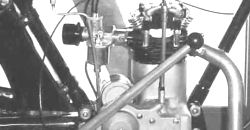


Scale motorcycles were produced by Harry J. Scale of Alexandra Park, Manchester, from 1906 to 1920.
1910 By now Harry Scale had entered the TT with a 3½ hp ohv JAP model. Although he had to retire from that, he had many other competition successes throughout his career, which proved the worthiness of his machines.
World War I. Production stopped for the duration of the war.
Post-war. Production restarted with a lightweight fitted with a 348cc Precision two-stroke engine. Finance was obtained through Messrs. Robert and Hibbs and this enabled a move to larger premises and increased production.
At that point the business was renamed New Scale and continued as such until 1925.
New Scale motorcycles were built from 1920 to 1925, by Harry Scale in Droylsden, Manchester, who had previously been responsible for the Scale marque.
1920 The Scale firm reformed to create New Scale. Various models were produced with Precision two-stroke, Blackburne and oil-cooled Bradshaw singles, all finished in a stylish cerise colour.
1921-1923 Various classes of the TT were entered with no success.
1924 A fourth place in the Sidecar race at the TT was the best result achieved. They tried out a 147cc Villiers lightweight with two-speed chain-cum-belt transmission. They also listed a machine fitted with a 349cc ohc Dart engine. Towards the end of the year, Harry Scale left the company.
1925 With just 349cc Bradshaw and 348cc ohv Blackburne models on offer, the company struggled on for one more season before calling it a day.

British Engine Builder
Fitted to numerous British and European motorcycles.
Bradshaw Engines

The improved Scale two-speed two-stroke model, fitted with a 350 c.c. engine and automatic lubrication.
THE Scale two-stroke motor cycles enjoyed quite a good reputation for sturdy construction before war requirements compelled their temporary withdrawal from public notice.
The makers, Roberts and Hibbs, Bank Street Works, Droylesden, Manchester, are now re-entering the field with a much improved model embodying the "Precision" 350 c.c. two-stroke engine which we described in our issue of May 29th last. This engine, as our readers are no doubt aware, is automatically lubricated from the sump, the magneto driving chain being used as the oil distributing agent.
Two types are being made, a plain two-speed model and a two-speed, clutch and kick-start model, listed at 65 and 70 guineas respectively.
Frame construction is on standard lines, and special attention has been paid to securing comfort for the rider by incorporating Brampton Bifiex forks and an XL'All saddle. The tank tapers slightly to the rear, and has a large petrol capacity, since all the oil is carried the engine. 26 x 2 1/4 in. tyres are fitted and T.B. magneto and Amac carburettor complete the specification. The general appearance of the machine is very good, being finished in deep crimson, black and gold with grey panelled tank.
The Motor Cycle, August 7th, 1919.

Special silencing arrangements are a feature of the Precision-engined 350 c.c. two-stroke New Scale.

How a large silencer may be inconspicuously carried on a two-stroke is shown by this vertical expansion box on the New Scale.
New Scale. (Stand 130.)
4 h.p. Blackburne; 85x88 mm. (499 c.c); single-cylinder four-stroke; side-by-side valves; drip feed lubrication; Amac carburetter; B.T.H. chain-driven magneto; three-speed Sturmey-Archer gear; chain and belt drive; Avon 26x2½ in. tyres. Price £126.
Roberts and Hibbs, Ltd., Bank Street, Droylsden, Manchester.
Manchester appears to have a distinct leaning towards startling colours for its motor cycle products. The recently introduced New Scale follows the lead of other factories in the same locality by adopting a vivid crimson colour scheme - with, however, a silver-grey panel on the tank which tones down the general effect very nicely. There is, however, a driven. Observe noticeable absence of unnecessary plating, and, combined with a simple, smooth outline, this machine should be very easy to keep in its original state of pristine brightness. Mud-guarding, too, is very adequate. Although, the New Scale embodies a very common combination of component parts - Blackburne engine, Sturmey-Archer gear-box, etc. - it is quite a distinctive little machine. The amply proportioned dummy belt rim front brake, the neat clip-up front stand, and the inclusion of Brampton Biflex forks in the specification are indicative of the thoroughness of the design. With sidecar, the outfit sells at £160.
3 h.p. Precision; 74x81 mm. (350 c.c); single-cylinder two-stroke; sump lubrication; Amac carburetter; B.T.H. chain-driven magneto; three-speed Sturmey-Archer gear; chain and belt drive; Avon 26 x2¼ in. tyres. Price £94 10s.
The 350 c.c. Precision two-stroke power unit is an engine that possesses quite a considerable reserve of power when used with a solo lightweight. The natural sequence, therefore, is attach a sidecar! This probability has been anticipated by Messrs. Roberts and Hibbs. They turn out their lightweight either suitable for sidecar work or actually as a sidecar outfit. Chances of strained, frames and similar mishaps are obviously reduced by this plan; and, in this case - a very important point - the usefulness of the machine for purely solo work is entirely unaffected. It remains light, low, and economical. Regarding details, there is little to note that has not been said before about the various well-known components utilised. A point, however, about the Precision sump system of lubrication is that, carrying oil in the engine, it allows a large capacity petrol tank to contain fuel only. On this machine an extremely large vertical silencer runs parallel with the cylinder.
The Motor Cycle, December 2nd, 1920. Page 722
Sources: Graces Guide, The Motor Cycle
See also: The History of Scale and New Scale Motorcycles